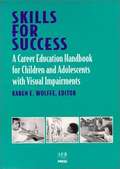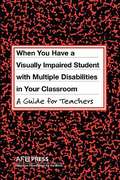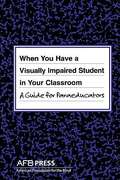Special Collections
American Foundation for the Blind
Description: American Foundation for the BlindPress offers a wide range of information for students, professionals, researchers, and blind and visually impaired people and their families. #teachers #disability
- Table View
- List View
Recreation Programming for Visually Impaired Children and Youth
by Jerry D. KelleyThe book is designed primarily for the recreation consultant or trainer concerned with assisting the community recreation leader in his or her efforts to provide recreation programs and services for the visually impaired child.
Report on Needs Assessment Methodology
by Anne Marie Delaney and Ronald L. NuttallThe major purpose of this report is to assist others who plan to conduct their own needs assessment for a blind population or for another special needs population.
Retrolental Fibroplasia and Autistic Symptomatology
by Joan B. ChaseIn this monograph, based on a study of 263 subjects with RLF (Retrolental Fibroplasia-- an eye condition caused by excessive incubator oxygen), the author examines selected variables which may significantly affect subsequent development.
Sex Education for the Visually Handicapped
by American Foundation for the BlindSexuality is at present very much in the spotlight. It is stressed over and again by educators and child psychiatrists how important a good sex education is for the optimum development of the child.
Skills for Success
by Karen E. WolffeInnovative materials for helping youngsters start on successful careers! Skills for Success details specific activities for preparing children with visual impairments for independence in daily life and success on the job. This comprehensive manual outlines how important capabilities can be developed through meaningful learning experiences at different ages. Contributors who are experts in their subject areas focus on suggestions for developing abilities leading to career and life satisfaction for preschoolers, elementary school students, and middle school students. Providing a wide range of information and resources, Skills for Success will prove an invaluable guide to teachers, parents, and others who work with children with visual impairments.
The Social Sources of Adjustment to Blindness
by Irving Faber Lukoff and Martin WhitemanThe impact of society on the blind is a complex issue, and many different tacks are necessary even if we are to only make little headway through the eddies and currents that alter and modify people's lives. This study is focused on the social forces that influence the adaptation of blind persons. The information derives from almost 500 interviews with blind persons selected from all walks of life.
Toward Independence
by Anne YeadonThis book is an introduction to the use of instructional objectives in the teaching of severely visually impaired persons. While it happens to use a daily living skills course as an example of how a teacher might develop a course around this educational method, it is not a daily living skills teaching manual. A creative teacher should be able to adapt the approach as described in Toward Independence to many other subjects.
Travel in Adverse Weather Conditions
by Richard L. Welsh and William WienerThis report marks the first attempt to pull together the knowledge of a large number of people related to the problem of travel in adverse weather for people who have visual impairments. These ideas represent the state of the art as defined by a wide sample of practitioners from all over the United States who participated in the National Conference on Travel in Adverse Weather in Minneapolis in February, 1975.
Vision and Aging
by Alberta L. OrrVision and Aging: Crossroads for Service Delivery focuses on the impact of visual impairment on older persons and their families. It also discusses the extent of that impact when services in the aging and blindness fields theoretically designed to enable older visually impaired persons to function independently are not available or accessible.
Visual Impairment
by Ian L. Bailey and Amanda HallA general, down-to-earth look at the common forms of vision loss and their impact on the individual. Explains the different aspects of visual impairment, describes adaptive techniques and devices, and provides information on available resources and services in a concise and easy-to-understand manner for busy professionals and visually impaired people and their families. Visual Impairment: An Overview seeks to clarify misconceptions and misunderstandings of the different aspects of visual impairment, describe adaptive techniques and devices, and provide information on available resources and services. Anyone with questions about vision loss will find this book a useful resource designed to increase understanding of visual impairment and the ability of visually impaired people to lead unimpaired lives.
Visually Impaired Seniors as Senior Companions
by Alberta L. OrrThe guide provides a framework for the reader to understand the core issues related to aging and vision loss, as well as the needs and capabilities of older visually impaired persons.
What Museum Guides Need to Know
by Gerda Groff and Laura GardnerThis book provides practical, easy-to-use suggestions on how to greet and assist blind and visually impaired visitors. It also covers aesthetics and visual impairment, legal requirements for accessibility, and resources. It includes a training outline for museum professionals, a bibliography on art and museum access for blind and visually impaired persons, and guidelines for preparing large print, braille, and cassette materials.
What of the Blind? A Survey of the Development and Scope of Present-Day Work with the Blind
by Helga LendeThis book is intended as a companion volume to What of the Blind? Recently published by the American Foundation for the Blind. The first volume was brought out in answer to a long-felt need for a convenient reference work to put in the hands of professional workers, board members and lay persons desiring general information on work with the blind. The subjects treated were mainly of a general nature as will be seen from the table of contents appended to this book.
What of the Blind? A Survey of the Development and Scope of Present-Day Work with the Blind
by Helga LendeWhat of the Blind? is designed with a view to presenting in one single volume the experience and opinions of leaders in this specialized field. The material has been grouped so that the student may easily find the aspect of the subject in which he is especially interested. Following each chapter is a short reading list which will serve as a guide to further study.
When You Have a Student with Visual and Multiple Disabilities in Your Classroom
by Jane N. Erin and Susan J. SpunginAs a special educator, a classroom teacher, or an educational team member, you may be working with a visually impaired student for the first time or as an experienced professional. This booklet provides information on how visual impairment affects learning in communication, movement, self-care skills, and other important areas, and on how to work effectively with students who have visual and other disabilities.
When You Have a Visually Impaired Student in Your Classroom
by Joanne Russotti and Rona Shaw and Susan Jay SpunginThis guide defines the paraeducator's role and how they work with other education team members. Subjects covered in the book include basics of visual impairment, tips for encouraging student growth and the special material and devices needed by the student. Forms are also included to help organize information and track progress.



